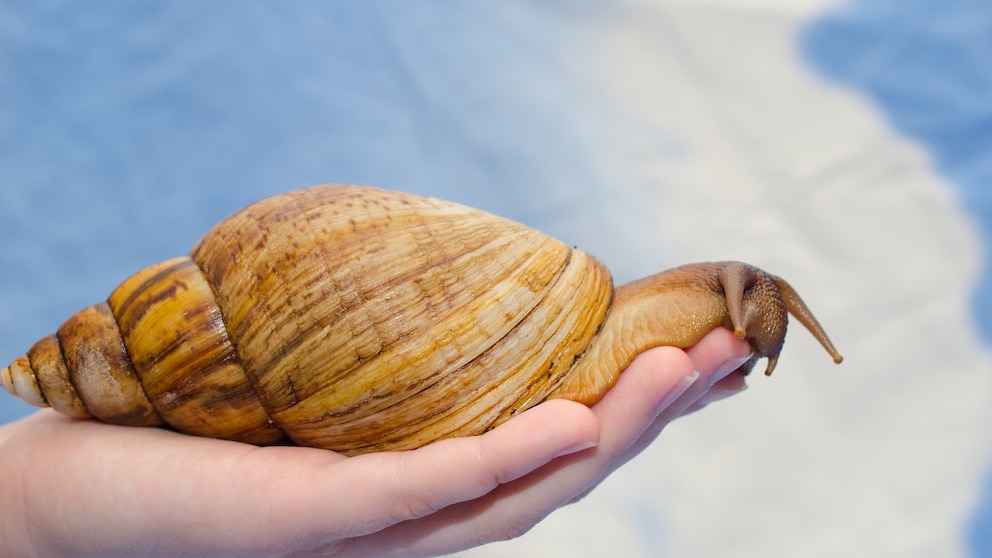April 20, 2025, 9:03 am | Read time: 4 minutes
The African giant snail captivates as the quiet star of the terrarium scene: enormous, slimy, and intriguingly different. On social media, these creatures are becoming cult figures. However, their exotic appearance should not obscure the fact that they require demanding care. PETBOOK editor and biologist Saskia Schneider explains what these exotic mollusks are really about, why they are so popular, and why they are also controversial.
Large, slimy, and fascinatingly different. That sums up the impression these exotic animals leave on many. The African giant snail, also known as the Achatina snail (family Achatinidae), is among the largest land snails in the world. As a pet, the species Lissachatina fulica is particularly popular, impressing with a shell length of up to 20 centimeters. Originally native to East Africa, it has spread to tropical regions worldwide due to human intervention, often with invasive consequences for local ecosystems. Its growing popularity as a pet not only sparks discussions about proper care but also about health risks: Studies show that these snails can potentially transmit pathogens like the rat lungworm. Despite their peaceful nature and ease of care, responsible handling is crucial.
Origin
The original home of the African giant snail is south of the Sahara, particularly in East Africa, where it is found in coastal regions and humid forests. From there, it has spread to nearly all tropical and subtropical continents through international trade and accidental introductions. Lissachatina fulica, in particular, is considered an invasive species in many of these areas, capable of displacing native fauna, damaging crops, and being a disease carrier. In countries like the U.S., Australia, and Canada, keeping this snail is, therefore, banned or strictly regulated. Importing them to Europe is allowed, but knowledge of their care is required. Establishing this species outside its native range poses a significant challenge for conservation, which is why the IUCN has listed it as a dangerous invasive species.
Appearance
African giant snails, especially the species Lissachatina fulica, are characterized by a conically shaped shell that can reach a length of up to 20 centimeters in mature individuals. In certain species, like Achatina achatina, lengths of up to 30 centimeters are possible. The shell tapers to a point at the apex and often has a reddish-brown base color with dark stripes or patterns, though coloration can vary greatly due to breeding lines. The shell is typically twice as high as it is wide, with seven to nine whorls. The body of the snail, like all snails, consists of a strong foot for crawling, four tentacles—two for touch and smell, two with eyes—and the radula, a rasping tongue with tiny teeth used to consume food.
Behavior
African giant snails are considered gentle and calm animals. Their nocturnal activity phase usually begins at dusk, when they search for food and explore their surroundings. Due to their slow pace and lack of defense mechanisms like biting or claws, they seem harmless—yet they are very sensitive to stress. Although many owners let the snails crawl over their hands, handling should be gentle. African giant snails are sensitive to touch, even through their shell, and may perceive it as a threat. As solitary creatures, they show little social behavior but are still kept in groups to prevent stress and susceptibility to disease. Overall, they are curious but reserved and focused on their environment.
Diet
African giant snails are herbivores but also consume animal protein. Their diet is based on fresh vegetables (such as cucumbers, carrots, spinach), fruits (such as apples, berries), and occasionally plant waste like banana peels. Animal protein, such as fish flakes or soaked dog food, should be given only in small amounts. Foods with salt, copper, or additives should be avoided. Additionally, calcium should be provided for shell growth—such as through cuttlebone, calcium powder, or clay. Food should be offered fresh daily and evenly distributed, ideally on trays to facilitate cleaning.

The 8 slowest animals in the world

How to keep chameleons in a species-appropriate way

How to Keep Tortoises Outdoors
Proper Care & Maintenance
Keeping African giant snails requires a terrarium with sufficient space—at least 60 × 30 × 30 cm for three to five snails. The substrate should be 10 cm deep and consist of undyed, slightly calcareous soil to protect the shell. The snails need high humidity (80–90%) and temperatures between 21°C and 28°C, with heating mats recommended but not heat lamps. A regulated day-night cycle can be established through lighting conditions. A water dish can be omitted with regular misting. Furnishings like cork branches or plants should be stable to prevent the snails from falling. Due to the risk of mold from food remnants, daily cleaning is essential. The snails can survive dry periods through a state called estivation, where they withdraw and remain inactive.
Handling the snails requires caution. On one hand, they can be easily injured if dropped. On the other, Swiss researchers warned against handling them, as their study found that African giant snails could theoretically transmit the rat lungworm, which can cause meningitis in humans. Therefore, they should not be allowed to roam freely in gardens, where they might come into contact with pathogens more quickly. Additionally, they are quite voracious and reproduce rapidly.

